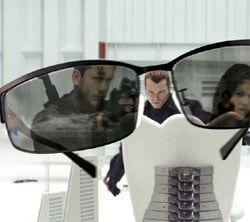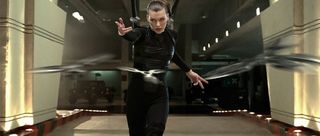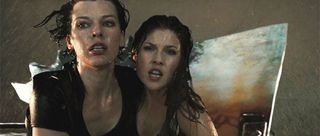To 3D Or Not To 3D: Buy The Right Resident Evil: Afterlife Ticket

As a potential moviegoer the biggest decision you face at the box office in 2010 isn’t which movie to see, but how to see it. Resident Evil: Afterlife opens in 3D this weekend and it’s just the latest in the now seemingly endless stream of 3D Hollywood releases churning their way through theaters across the country. Though it’s not exactly getting great reviews, for the record, I had a good time watching. But this won’t be a discussion of Afterlife’s merits as a film.
Instead our goal here is to give you an unbiased guideline to help you, as a movie ticket buyer, decide how to see it. 3D tickets are more expensive than 2D tickets yet, 3D isn’t always the best way to see every movie. To help you navigate the increasingly confusing 3D tidal wave, I’ve developed a straightforward, 7-point system for determining whether 3D is the right choice for you when seeing this film. In order for this analysis to work, for better or worse, I’ll ignore the quality of Resident Evil: Afterlife as a story and instead give an assessment of the movie’s 3D on a mostly technical level. Using that, you’ll have the tools you need to buy the right Afterlife ticket in the right format, and at the right price. Read on.

Is 3D A Fit?
In the past 3D has worked best on animated movies or in the case of Avatar a live action movie with a high-percentage of computer generated imagery. While Afterlife uses a lot of computer generated effects, most of the movie is live action and so on the surface it might not seem like a fit for 3D… but it is. Most of the movie uses simple, high-contrast sets and while much of the foreground is indeed live action most of the background is constructed with CGI compositing which works well with 3D, especially when the movie’s actually filmed in 3D, which Resident Evil: Afterlife was. There’s the nature of the story too which, let’s face it, it’s much of a story. The story only really exists to service the special effects, special effects which have been designed around getting the most out of 3D. The movie’s a fit for 3D because it was made to be in 3D. They’ve sacrificed everything, story, character, sensible plot devices, to make it fit in 3D. And it does. As well as any live action movie can.
3D Fit Score: 5/5

Advance Planning And Effort
This is the second movie since Avatar filmed using James Cameron’s 3D Fusion Camera System. The movie was planned in 3D, written to be in 3D, and shot in 3D. For better or worse it was always going to be in 3D. Director Paul W.S. Anderson created his movie accordingly. He used the best possible technology available to make that happen. Resident Evil: Afterlife isn’t an innovator, it’s not coming up with anything new, it’s not pushing the technology to a new level, but it is doing everything possible with the best of what’s available and that’s more than can be said of any 3D movie that’s been released in theaters since Avatar. Is it a 3D craze cash-in? Absolutely, but it’s one that’s cashing in, well, the right way. They planned ahead for 3D and the put a maximum amount of effort into it, with whatever amount of time they had available to shoot it.
Planning And Effort Score: 5/5

Picture Depth
CINEMABLEND NEWSLETTER
Your Daily Blend of Entertainment News
The reason most often given for converting movies into 3D is depth. Used properly 3D can give the picture in front of you the illusion of extra depth and make it feel as though you're watching something happening through a window, rather than flat images projected on a screen. Resident Evil: Afterlife does that, and does that well. Except, well, there’s never that moment where it makes you feel as though you’re watching something real. It’s not through any failure on the part of the technology, Afterlife isn’t trying to show you something real. It’s not as though it’s trying to create a realistic sensation and fails at it. Afterlife is more interested in using 3D to show you something cool, and the result is 3D used to create the kind of a hyper-real depth that makes it seem as though you’re peering down into a video game, and not real life. It’s not an accident, it’s what they’re going for. For some people that’ll work, for some maybe it won’t. I loved it.
Picture Depth Score: 5/5

Brightness
One of the biggest problems with 3D is the haze created by those filtered glasses you're forced to wear. Normally it’s especially a problem in live-action movies, where without the brighter colors of animation, the image on screen is turned into an incomprehensible muck. But Resident Evil: Afterlife deals with this effortlessly. It compensates for the brightness problem by ignoring the shadows and varying light sources of reality which, let’s face it, 3D just cannot handle, and instead creates it’s own kind of hyper-reality. In Afterlife every scene is composed of extremely high-contrast pictures which, in their own way, almost mimic the bright, sharp-edged images of animated movies which have worked well with 3D in the past. Even in dank or dark scenes, which in other live-action 3D movies are usually a complete disaster, are an absolute joy in Afterlife. Any environment, any light level, is no problem. The 3D haze of other third dimension movies is non-existent here, blasted away by director Paul W.S. Anderson’s clearly defined, perfectly lit, video game style.
Brightness Score: 5/5

Flair
3D can be gimmicky, with characters thrusting things towards the camera in an effort to scare the audience. But those gimmicks can also be used to add extra value. 3D can come out of the screen as well as go in, and if you’re going to use the technology, why not use all the tools available to you. Filmmakers too one dimensional to use 3D’s full potential are wasting half its power. Others use all of it, but use it incorrectly. Afterlife goes about it the right way and not only uses 3D to provide depth but thrills the audience with the occasional giant axe flying out of the screen as well. There’s never a scene as brilliantly executed as the seed pods floating over your heads in Avatar, it’s never that ambitious and it’s not about pushing the envelope here, but Afterlife makes the effort and because they’ve used the right technology and created a movie which was designed to make full use of 3D right from the start, it utilizes the full range of 3D technology doesn’t make a complete mess of it.
Flair Score: 3/5

Audience Health
This is a somewhat subjective criteria since 3D affects different people differently. Many people have reported persistent headaches with all forms of 3D, some simply can't see in 3D at all. Take all of that into consideration before seeing any 3D movie. I can report no dizziness, headache, or fatigue caused by Resident Evil: Afterlife. In talking to some around me, I did however hear some reports of fatigue from those near me. In general though, because the movie handles the brightness problem so well that should eliminate a lot of the eyestrain issues caused by many 3D movies. Dimly lit 3D movies are the ones most likely to cause illness, headaches, and other health problems. It is however, an extremely fast paced, action focused movie and that could cause dizziness in viewers unused to 3D, even though the film handles the technology so well.
Health Score: 3/5

The Glasses Off Test
The last time you took off your glasses during a good 3D movie, you probably noticed that during the most intensive parts of the film, the picture on screen became even fuzzier. The easiest way to explain this is to say that the blurrier the image on screen appears when seen without glasses, the deeper and more vibrant the 3D is likely to be with your glasses on. So to test this, I removed my 3D glasses periodically during Resident Evil: Afterlife to examined the way the movie’s 3D effects were being created. As you’d expect in a movie where the 3D is such a focus of what’s happening, the film was almost unwatchable, throughout, without 3D. Unlike many 3D post-conversions, there was never that moment in the movie where you could be just as comfortable watching it without glasses as with. Resident Evil is maxed out 3D, one-hundred percent of the time. It takes the technology to the limit.
Glasses Off Test: 5/5
| SCORES RECAP | |
| 3D Fit | 5 |
| Planning and Effort | 5 |
| Picture Depth | 5 |
| Brightness | 5 |
| Flair | 3 |
| Audience Health | 3 |
| The Glasses Test | 5 |
| Total Score | 31 (out of a possible 35) |
Final Verdict: Resident Evil: Afterlife is the first live-action movie I’ve seen this year that actually looks good in 3D. Even Avatar really wasn’t live action. More than 60% of Cameron's film was entirely computer generated. Afterlife works because, unlike every other 3D movie released in 2010 (except Step-Up 3D), it was actually filmed in 3D. But that’s really only part of it. Even then, live-action is still problematic. It’s Paul W.S. Anderson’s hyper-real video game aesthetic that makes it work so well in the format. Maybe his look isn’t the best way to tell a story, but right now it seems to be the only way to tell a story in 3D. For better or worse, Resident Evil: Afterlife works in 3D. Does it make it a better movie? I’m not sure 3D really makes any movie better, but at least it works on this one, and if Hollywood’s going to keep churning them out, that’s all we can ask for.
For more 3D analysis, visit our To 3D Or Not To 3D archive right here.
Most Popular






